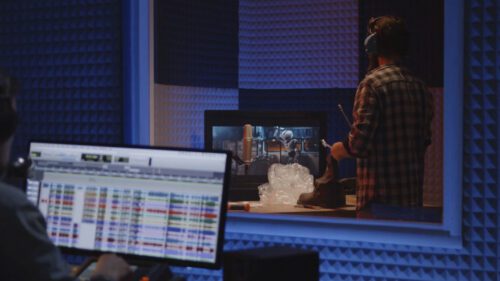It’s one thing to try your best when you’re creating videos. But if you’re always expecting perfection you’re only setting yourself up for disappointment. Aiming for perfect work 100% of the time isn’t realistic (or good for your mental health). A better way to approach video creation is figuring out what works through testing and iterating on your videos. That way, you’re able to use hard data to prove out success rather than creating in a vacuum.
Testing and iteration is how good enough videos become great videos. It’s a methodical fine-tuning process that can improve your videos with every step. It may seem complicated, but there are tools at your disposal that make it easy to get started. We cover all of these resources in detail inside our new guide, “How to create a contemporary video strategy”. Testing and iteration can be as high-level as brainstorming video concepts, or making tiny tweaks to a video to see how it affects performance.
Advice from experts on testing and iterating on your videos
In researching our new guide, we spoke to seasoned marketing and video production leaders about testing and iteration. In-house experts at Storyblocks as well as from enterprise partners HubSpot and Descript shared how their years of experience helped them realize that refining their videos is a gradual process. Our expert line-up included:
- Kyle Denhoff, Director of Marketing, HubSpot
- Lara Unnerstall, Video Producer, Descript
- Ryan Vig, Marketing Leader, Descript
- Lauren Zoltick, Director of Performance Marketing, Storyblocks
- Kaitlyn Rossi, Senior Producer, Storyblocks
Download Storyblocks’ How to create a contemporary video strategy guide today to find out how these professionals learned to stop chasing instant perfection.
Focus on efficiency and be intentional
Like any other part of your production, it’s important your testing and iteration process runs efficiently. Efficiency is especially important with video marketers feeling the pressure from reduced budgets and a shaky economy. For starters, you’re more likely to get actionable insights from testing if you focus on what’s most likely to move the needle. Teams may feel pressured to test random things with no particular purpose, like a different colored backdrop, but that’s unlikely to make a difference in your metrics.
As Storyblocks Senior Producer Kaitlyn Rossi points out, you’ll get much better results when you’re “very intentional with what you’re choosing to test and make sure that it’s impactful.” She explains that “The likelihood of [a randomly chosen variable] being a reason why someone’s converting is very small versus a change in value proposition, the copy, or the way the video starts.” So when you’re considering what to test, it’s better to look at the more substantial parts of your video. Don’t focus on small details that most users won’t notice.
One way to look at the testing and iterating process is to approach it like a scientist. As you’re making adjustments to your videos to see how your audience responds, only change one element at a time. That way you won’t wind up in a situation where you notice a performance boost, but can’t pinpoint which change made the difference. As Lauren Zoltick, Storyblocks’ Director of Performance Marketing suggests, “pick one little thing to A/B test at a time, figure out which one is better, and then move on to the next piece of testing in your next creative iteration.” And always be sure to repeat your tests to account for other outside variables, like the time or day you posted your video.
Size matters when it comes to testing
There are two approaches you can take when testing and iterating your videos – “testing big” and “testing small”. Both methods will yield different types of information, so a combination of the two is ideal.
How to test big with video
Testing big is an effective way to determine the style and tone of video that best resonates with your target audience. It starts by pitting two very different video concepts against one another. From there, the dueling concepts are refined in a team brainstorming session. That will help you figure out which ideas are most likely to help achieve your strategic goals. Then, once you’ve made rough cut versions of the videos, get them out quickly and record your results. Remember that the goal here is speed, not perfection. And keep in mind some results will be more valuable to you than others.
For instance, measurements like watch time are important, but they’re not necessarily the most relevant to your video’s goal. “It’s so easy to get lost in the data and just be like metrics metrics metrics. Focus on what you’re looking at, and have a reason for why you’re focusing on those things,” offers Lara Unnerstall, Video Producer, Descript. Instead, Lara suggests looking at things like whether viewers took the conversion action you set as a goal. Let’s say your objective for a video is raising brand awareness. An uptick in web searches or homepage visits following publication would be more relevant success metrics than how long viewers spent watching.
How to test small with video
Testing small is much more precise. It’s an iterative strategy where you make minor changes to existing videos one at a time to gradually get it closer to perfection. Using a video production platform with unlimited stock footage is an excellent resource for testing. A massive selection of content gives you and your team the tools you need to rapidly iterate on your videos. This makes it a lot easier (and faster) to experiment with different cuts, music, and much more. Storyblocks provides professional looking After Effects and Adobe Premiere templates that can help you test and iterate on your videos faster than you ever thought possible.
Performance marketing can be an affordable channel for testing out small changes. There, you can test out changes like call to actions, script variations, or even the location of the subjects of your videos. Ryan Vig, Marketing Leader for Descript, says the type of testing he’s most excited about are those which “can help you bring learnings to other parts of your marketing.” Testing small is also a useful low-risk way to test the waters on a new social platform or content channel.
You can easily mine your existing YouTube videos for bite-sized segments more appropriate for TikTok, for instance. With some quick slicing and dicing, you’ll have a fresh ready-to-publish video in no time. If it’s the first time you’ll be publishing to the platform, the data your test run reveals will give you a baseline to start from with virtually no upfront cost. User-friendly platforms like Maker for Teams give even video non-experts the opportunity to lend a hand creating videos and let their creativity shine.
Want help deciding what approach to testing and iterating is best for your videos? Download our How to create a contemporary video strategy guide today.
Test more than just the content of your videos
When testing and iterating on your videos, there’s much more you can test than just the actual content. Testing video titles or even when you upload can give you learnings and improve performance. Experimenting with these elements can sometimes yield unexpected results. And they can reveal valuable insights about your audience that you can put to use later.
One type of testing and iterating in particular was frequently cited by the experts we spoke to for our video strategy guide: the thumbnail. There was strong agreement that swapping out thumbnails is a fast and inexpensive way to iterate. And it can be a great way to juice views for an underperforming video. “A/B test your thumbnails. Invest in thumbnails,” says Kyle Denhoff, HubSpot’s Director of Marketing. “Because it’s going to increase your click-through rates on your videos.” Kyle says HubSpot considers thumbnails to be “the packaging” of any video they produce. “We feel like the packaging of the content we create is going to attract eyeballs and attract audience members, so we actually spend a lot of time there.” So if you haven’t tested it before, it’s an excellent place to start.
For even more expert insights about testing and iterating, check out Episode 8 of our Beginner’s guide to creating video. This episode is all about how to test and optimize your videos for peak performance.
Learn more about testing and iterating on your videos directly from the pros

Production teams and video marketers in every industry are facing shrinking budgets this year. One way they’re doing more with less is by refining their video testing and iteration strategies. We covered the basics here, but if you want to read more, download our How to create a contemporary video strategy guide for free today.



